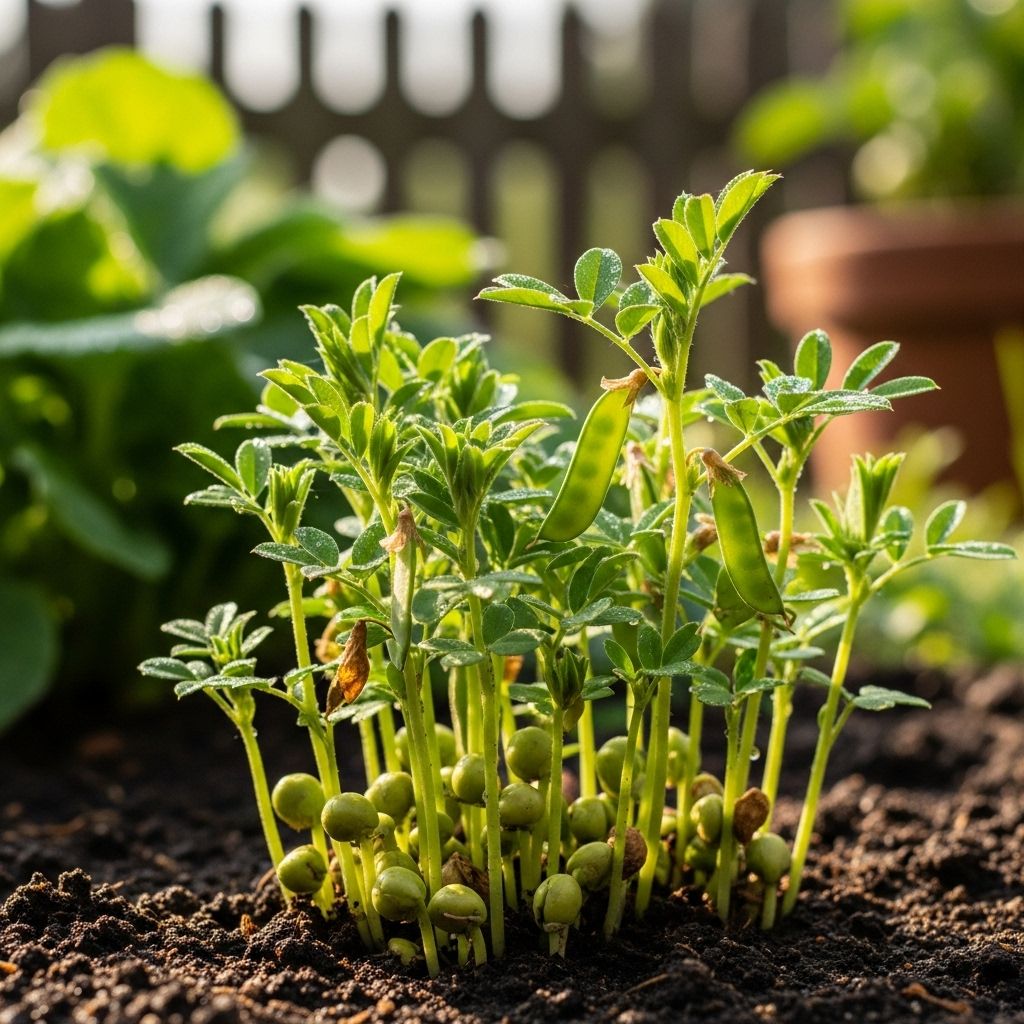Growing Lentils: Complete Guide For Homegrown Protein
Experience a step by step route to a thriving legume harvest in any garden.

Growing Lentils: Step-By-Step Guide to Homegrown Protein
Lentils are an ancient, protein-packed legume that can be grown at home for a nourishing, sustainable harvest. This detailed guide covers every aspect of cultivating lentils in your garden, including planting, care, pest management, harvesting, and storage. Whether you’re a beginner or an experienced gardener, you’ll gain practical, actionable knowledge to successfully grow these nutritious legumes.
Why Grow Lentils?
Lentils are loaded with protein, fiber, vitamins, and minerals, making them an excellent source of nutrition for plant-based and omnivorous diets alike. These legumes have been a dietary staple for millennia, renowned for their versatility in soups, stews, and salads. Homegrown lentils offer several unique benefits:
- High nutritional value: Rich in protein, iron, and B vitamins.
- Soil enhancement: As nitrogen-fixing legumes, lentils improve soil fertility for future crops.
- Low water requirements: Suitable for less irrigated or drier gardens.
- Easy to store once dry, with a long shelf life.
- Open-pollinated varieties allow home seed saving and sustainable gardening.
Planting Lentils
With the right preparation, lentils are a rewarding addition to both urban and rural gardens. Here’s how to get started:
When to Plant
- Sow lentil seeds indoors about 2 weeks before your region’s last expected spring frost date.
- For direct sowing, wait until after the final frost, when soil temperatures reach ~68°F (20°C).
- Germination typically occurs within 7-10 days in optimal conditions.
Site Selection
Choose a sunny, open site in your garden:
- Full sun: Lentils need at least 8 hours of direct sunlight per day.
- Good air circulation to reduce disease risk.
Soil Preparation
- Lentils perform best in well-draining, loose soil enriched with organic matter like compost.
- Optimal pH: 6.0 – 7.5 (neutral to slightly alkaline).
- Avoid heavy clay or waterlogged areas as lentils are highly susceptible to root rot.
How to Plant Lentil Seeds
- Amend bed with compost or well-rotted manure a few weeks in advance.
- Sow seeds 1 inch (2.5 cm) deep and 1-2 inches (2.5-5 cm) apart in rows spaced 12-18 inches (30-45 cm) apart.
- If transplanting from indoors, carefully move seedlings outside after hardening off, spacing as above.
- Water lightly after sowing and keep soil moist (not wet) until seedlings emerge.
Caring for Lentil Plants
Consistent care leads to robust plants and a good yield. Lentils are generally low-maintenance but benefit from attention to the following:
Sun and Temperature
- Full sun is preferred for robust growth and healthy pods.
- Lentils thrive in cool to moderately warm weather. They are sensitive to frost (avoid temperatures below 50°F/10°C) and may drop flowers or develop fewer pods in prolonged heat above 90°F (32°C).
Watering
- Lentils are moderately drought-tolerant once established, but require consistent moisture during flowering and pod formation.
- Water deeply but infrequently, letting soil dry slightly between waterings.
- Avoid overhead watering to reduce the risk of mildew and other foliar diseases.
- Apply mulch to retain moisture and suppress weeds.
Fertilization
- Lentils, as legumes, fix their own nitrogen from the atmosphere and typically do not require high-nitrogen fertilizers.
- Add phosphorus and potassium only if your soil test shows deficiency.
- Avoid over-fertilizing, which can result in excessive foliage and reduced yield.
Staking and Support
- Lentil plants are small and bushy, usually growing 12-24 inches (30-60 cm) high, but may sprawl or lodge under heavy rain or wind.
- Light support such as pea netting or stakes helps keep plants upright for easier harvesting and better airflow.
Weeding
- Lentils compete poorly with weeds, especially during early stages.
- Hand-weed or use shallow hoeing to avoid disturbing shallow roots.
- Mulching with organic material helps suppress future weed growth.
Common Problems and Solutions
| Problem | Symptoms | Prevention/Treatment |
|---|---|---|
| Root Rot | Wilting, yellowing, poor growth | Improve drainage; avoid waterlogged soils |
| Aphids | Sticky foliage, distorted leaves, visible insects | Spray with strong water jet; encourage ladybugs |
| Powdery Mildew | White powdery spots on leaves and stems | Provide good airflow; apply organic fungicide if needed |
| Cutworms | Seedlings cut at soil line | Use collars around seedlings; hand-pick at dusk |
Harvesting Lentils
Proper harvest timing ensures the best flavor, nutrition, and storage quality.
Harvest Timing
- Harvest lentils when most pods have turned tan or brown and the lower leaves have dropped.
- The plant should be largely dry, but avoid waiting until all pods shatter to prevent seed loss.
- For fresh eating, pick while pods are still green and seeds are tender.
How to Harvest
- Pull entire plants by hand or cut at the soil line with garden shears or a sickle.
- Lay plants on a cloth or tarp in a well-ventilated, dry area to finish curing if needed.
- Once fully dry, thresh the pods by gently rubbing or beating the plants to release lentil seeds.
- Clean seeds by removing any debris or chaff.
Storing Lentils
- Dry lentils can be stored in airtight containers in a cool, dry, dark place for up to a year or longer.
- Check periodically for signs of pests or moisture—and discard any compromised seeds immediately.
- Freezing for several days before long-term storage (optional) kills any possible insect eggs.
Growing Lentil Sprouts & Microgreens
In addition to mature lentils, you can enjoy delicious and nutritious sprouts or microgreens from your harvest:
- Sprouting: Soak whole lentils for a few hours, drain, and rinse twice daily. In 2-4 days, you’ll have fresh lentil sprouts for salads or sandwiches.
- Microgreens: Sow lentil seeds thickly in a shallow tray, keep moist, and harvest young shoots at 2-3 inches tall.
Popular Lentil Varieties
| Variety | Seed Color | Flavor/Use |
|---|---|---|
| Brown Lentils | Light to dark brown | Earthy, versatile; great for soups, stews |
| Green Lentils | Pale green | Peppery flavor, holds shape; good in salads |
| Red Lentils | Orange to red | Slightly sweet, soft texture; quick-cooking |
| Black Lentils (Beluga) | Jet black | Firm texture, great visual appeal |
| Yellow Lentils | Pale yellow | Mild, used in Indian dal and purees |
Companion Planting for Lentils
- Lentils grow well with carrots, cucumbers, and cabbage family members.
- Avoid planting with onions or garlic, as these can stunt lentil plants.
- Include flowers like marigold nearby to help deter pests naturally.
Frequently Asked Questions (FAQs)
Q: Are lentils easy to grow for beginners?
A: Yes, lentils are low-maintenance compared to many other legumes. As long as you ensure proper drainage and full sun, they thrive with minimal additional care.
Q: Can I grow lentils in containers?
A: Yes, use wide, deep containers filled with loose, well-draining soil. Stake plants if needed for support. Container growing may limit yields but allows for urban and indoor gardening.
Q: How much yield can I expect per plant?
A: On average, each lentil plant produces a modest amount, with several pods containing 1-2 seeds each. Expect 1-2 cups of dry lentils per 10-foot row in good conditions.
Q: Do I need to inoculate lentil seeds?
A: It’s beneficial in low-nitrogen soils to use a Rhizobium inoculant specific to lentils to improve nitrogen fixation and plant vigor.
Q: Are lentils susceptible to many pests or diseases?
A: Lentils are relatively low in pest and disease pressure but can suffer from root rot in poorly drained soils, aphids, and fungal diseases under wet or humid conditions. Proper care minimizes risks.
Tips for a Successful Lentil Crop
- Rotate lentil crops to a new spot every year to prevent disease build-up.
- Sow extra seeds in case of poor germination or pest losses.
- Start with certified disease-free seed for best results.
- Regularly check for signs of pests or disease and act early if observed.
- Avoid harvesting during wet weather to prevent pod rot and fungal issues.
Conclusion
Lentils are a sustainable, nutritious addition to any home garden. With their ability to thrive on minimal water, improve soil fertility, and provide a reliable source of protein, they are an ideal crop for gardeners of all skill levels. Follow these best practices, and you’ll enjoy homegrown lentils from seed to plate—year after year.
References
Read full bio of Anjali Sayee












